Authentic Lowcountry Cornbread: The Ultimate No-Flour, No-Sugar, Gluten-Free Recipe
For many years, my cornbread preferences leaned towards recipes that incorporated a touch of sugar and a small amount of all-purpose flour. I enjoyed the slightly sweeter, softer texture these additions provided. However, over time, my palate has truly embraced and fallen in love with a more traditional, rustic style of cornbread – specifically, this remarkable Lowcountry cornbread recipe. What sets it apart is its pure, unadulterated corn flavor, achieved by omitting both flour and sugar, making it naturally gluten-free and inherently savory.
This particular iteration of no-flour, no-sugar cornbread holds a special place in my heart, deeply rooted in family tradition. It’s akin to the cornbread my father would enjoy alongside a hearty bowl of Hoppin’ John, a classic Southern New Year’s Day dish. This means it’s the unsweetened variety, designed to be drizzled liberally with rich sorghum syrup or the unique Steen’s cane syrup, adding a customizable sweetness at the table. My great-grandmother also favored this type of savory cornbread, often mashing it directly into a glass of cool buttermilk for a simple, nourishing meal. While it’s phenomenal paired with stews, beans, or greens, this robust, non-sweet cornbread also shines brightly as a stand-alone treat. Its straightforward preparation, combined with its gluten-free nature and rich, authentic flavor, makes it an exceptionally easy and rewarding bake.
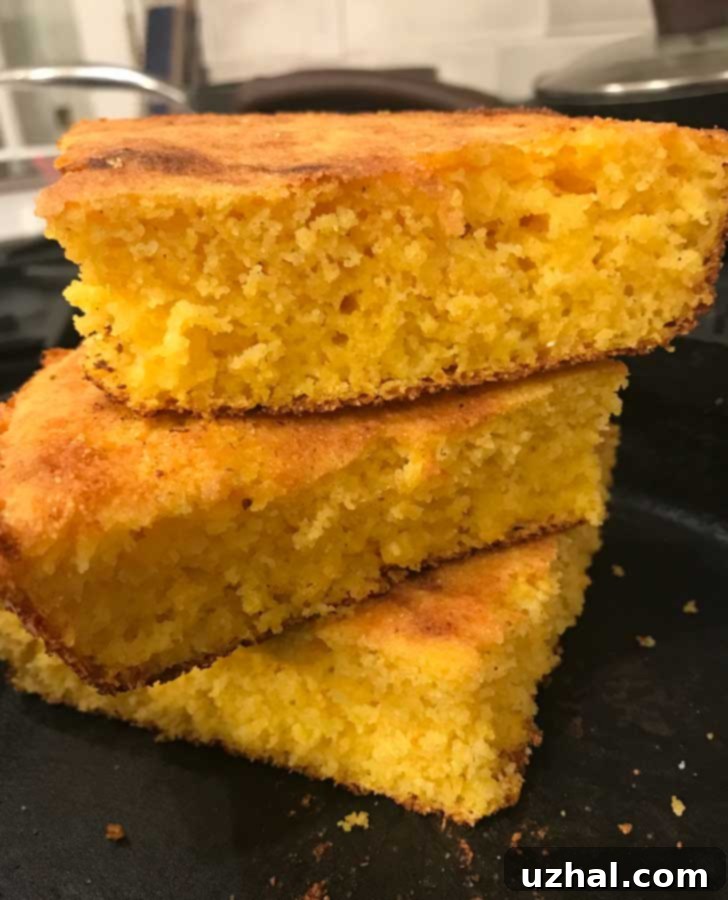
The Essential Fat: Bacon Fat, Butter, or Neutral Oil for Superior Cornbread
Beyond being a fantastic gluten-free option, this traditional Lowcountry cornbread recipe is also surprisingly lean, requiring a minimal amount of fat. I’ve consistently achieved excellent results using just 2 teaspoons of rendered bacon grease, melted butter, or a flavorful combination of the two. The choice of fat subtly influences the final flavor profile – bacon grease imparts a deep, savory, smoky undertone that is quintessentially Southern, while butter offers a rich, golden hue and a creamy texture. For those seeking a strictly vegetarian or neutral flavor, a good quality vegetable oil can also be used effectively, ensuring the cornbread remains a versatile addition to any menu.
The absolute key to truly exceptional cornbread, as with many cast-iron skillet recipes, lies in getting the skillet and its chosen fat incredibly hot before introducing the batter. When the batter hits that sizzling hot surface, it immediately begins to cook and caramelize around the edges, forming that coveted crispy, golden crust that is the hallmark of authentic Southern cornbread. My preferred method involves frying two or three slices of bacon directly in the cast iron skillet while I’m preparing the cornbread batter. This not only yields delicious bacon (which, importantly, does not go into the cornbread itself but can be enjoyed separately or saved for another dish) but also leaves behind a perfect layer of still-hot, flavorful bacon fat. This rendered fat, along with the intensely heated skillet, provides the ideal environment for the cornbread batter to transform into a crusty, tender masterpiece. This technique ensures a non-stick surface and an unparalleled texture that cannot be replicated with a cold skillet.
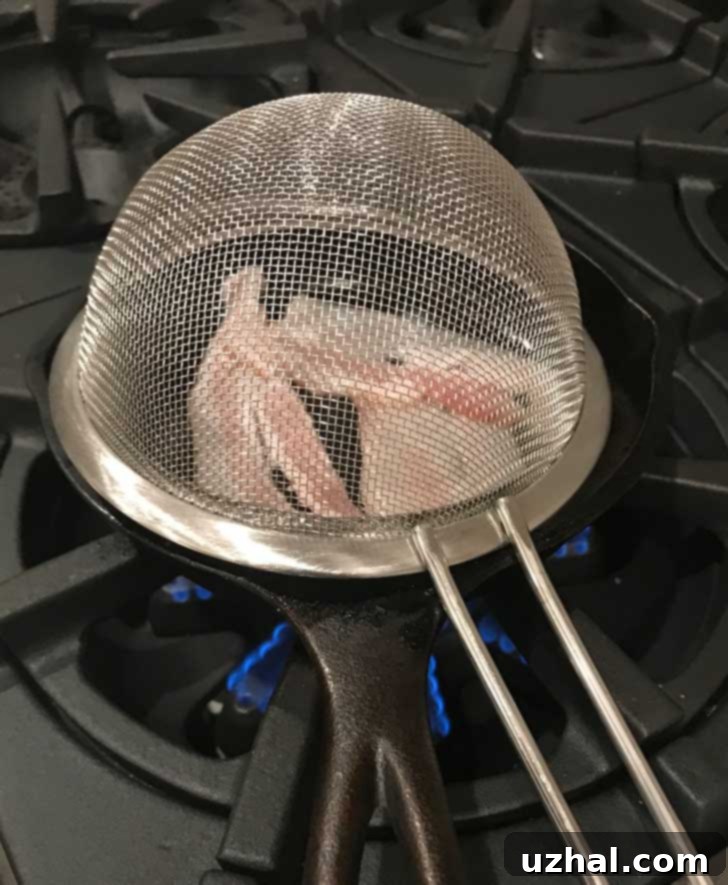
Discovering the Roots of Traditional Lowcountry Cornbread
I am immensely grateful to have discovered and perfected this traditional Lowcountry cornbread recipe. Honestly, I might not have ventured into this specific style had it not come from an extraordinarily trusted and highly reliable source: the renowned culinary historian and author, John Martin Taylor, also affectionately known as Hoppin’ John. For anyone with a keen interest in the rich, diverse flavors and fascinating history of Lowcountry Cuisine, I highly recommend exploring his work. His books are invaluable resources that delve deep into the regional culinary traditions of coastal South Carolina and Georgia. I was fortunate enough to stumble upon one of his seminal cookbooks at a charming used bookstore in Charleston, a true treasure trove of local history and flavor. Since then, I’ve made plans to acquire more of his titles online, as his meticulous research and engaging storytelling bring each recipe to life. He provides not just instructions, but also a wealth of historical context with every dish, offering insights into the ingredients and techniques that shaped Southern cooking. Through his writings, I’ve even encountered intriguing, lesser-known breads I’d never heard of before, such as Philpy, a unique rice bread made with a combination of cooked rice and rice flour, highlighting the ingenuity and resourcefulness of historical Lowcountry kitchens. But let’s circle back to the star of the show: this incredible cornbread.
The Lowcountry region, with its distinctive blend of African, European, and Native American influences, boasts a culinary heritage unlike any other in the United States. Cornbread, in its various forms, has always been a cornerstone of this cuisine, serving as a versatile accompaniment to almost every meal. This particular recipe embodies the true spirit of Lowcountry cooking: simple, hearty, and intensely flavorful, relying on the quality of its core ingredients rather than superfluous additions. It represents a culinary lineage that prioritizes substance and tradition, a staple food that has sustained generations and continues to define Southern comfort.
The Heart of the Batter: Selecting the Right Cornmeal and Buttermilk
The quality and type of cornmeal significantly impact the texture and flavor of your cornbread. For this Lowcountry recipe, I’ve consistently achieved excellent results using readily available fine cornmeal, specifically regular old Quaker brand and Publix brand. There’s no need for anything extraordinarily fancy or obscure; these common brands deliver a consistent, fine texture that results in a tender crumb and a delightful crust. While stone-ground cornmeal offers a more rustic texture and often a deeper corn flavor, fine-ground cornmeal creates a smoother, more uniform consistency that many prefer for this style of cornbread. The key is to avoid “cornbread mix” which often contains flour, sugar, and leavening agents, deviating from the pure, traditional profile we’re aiming for.
Equally crucial is the buttermilk. I’ve found that cultured full-fat buttermilk yields the best results, contributing to a richer flavor and a more tender, moist crumb. The acidity in buttermilk reacts with the baking soda and baking powder, creating the necessary lift and aeration for a light, yet substantial, cornbread. Here in North Carolina, I haven’t encountered any issues finding full-fat buttermilk, which is wonderful. However, I understand that in some markets, lower-fat or even non-fat buttermilk might be more prevalent. While I haven’t specifically tested this recipe with lower-fat versions, it’s generally recommended to stick to full-fat if possible for optimal taste and texture. If full-fat cultured buttermilk is unavailable, a decent substitute can be made by adding 1 tablespoon of lemon juice or white vinegar to a measuring cup and filling the rest with whole milk to the desired amount, letting it sit for 5-10 minutes until it slightly curdles. While not a perfect replica, it will provide the necessary acidity for the leavening agents.
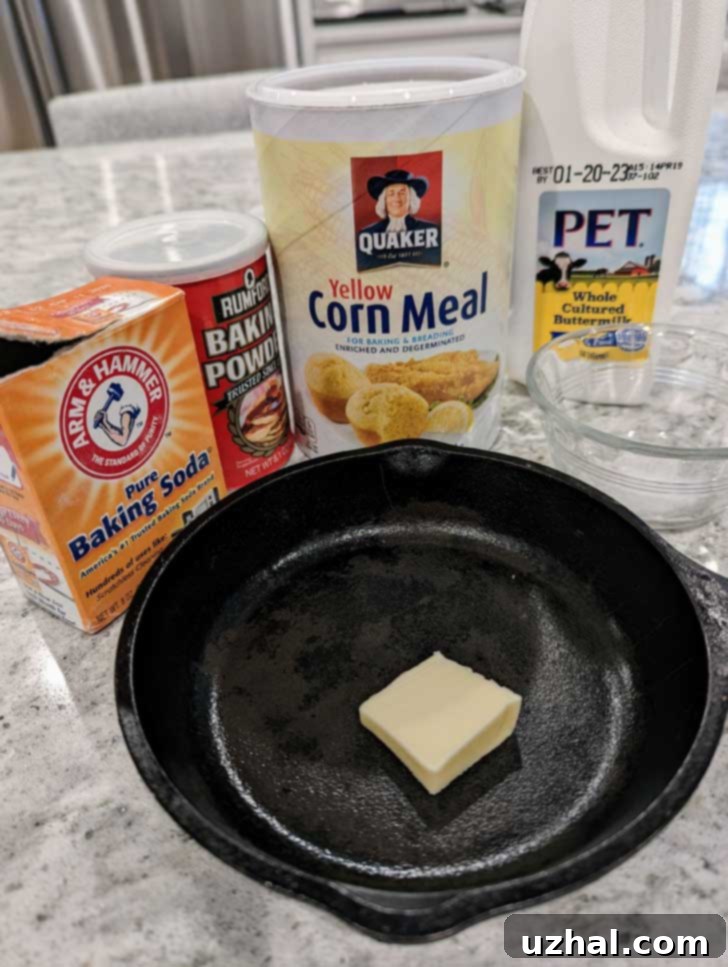
Scaling Down: Perfect Half and Quarter Batches of Lowcountry Cornbread
Sometimes, a full batch of cornbread is simply too much, especially for smaller households or when you’re just craving a modest serving. The beauty of this Lowcountry cornbread recipe is how easily it scales down without compromising quality. If you happen to own a 6 ½ inch cast iron skillet, you can effortlessly prepare a perfect half-batch version of this recipe. The process is straightforward: simply halve all the ingredients. When it comes to the egg, you’ll need approximately 2 tablespoons of a beaten large egg, which is roughly half an egg. This precision ensures the correct moisture content and structure for your smaller cornbread. Follow the exact same directions as the full recipe, maintaining the high heat of the skillet and fat for that essential crispy crust.
When making a half batch in a smaller skillet, you will likely find yourself filling the skillet almost completely to the brim. While tempting to pour every last drop of batter in, it’s wise to exercise caution. If you do decide to use all the batter, it’s highly recommended to place a rimmed baking sheet underneath your skillet in the oven. This simple precaution will catch any potential drips or overflows, saving you from a messy oven cleanup. For an even smaller portion, you can quarter the recipe. This will result in a noticeably thinner cornbread, which is actually a fantastic outcome for many enthusiasts. A thinner cornbread means a significantly higher crust-to-crumb ratio, offering more of that delicious, crispy exterior in every bite. Given the fluctuating cost of eggs (though thankfully, prices have stabilized recently!), using a specific weight for a quarter egg (around 12-15 grams) is a great way to be precise and avoid waste, saving the remainder of the egg for another mini-batch or a different recipe. That being said, this cornbread keeps remarkably well, so making a full or half batch is often still a practical choice, even if it means finding a creative use for that leftover half egg in something else, like scrambled eggs or baking.
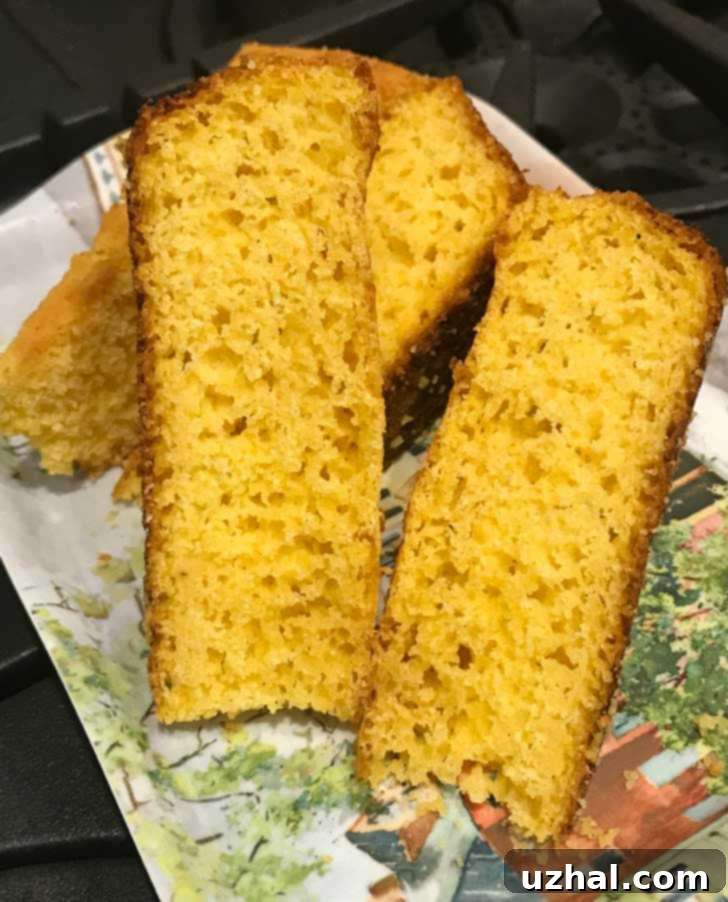
The Unsung Hero: Leftover Lowcountry Cornbread
While most cornbread is undeniably at its peak when served fresh from the oven, still warm and fragrant, this particular Lowcountry recipe has a surprising secret: it’s incredibly delicious as leftovers. In fact, I dare say that on occasion, the leftover pieces develop an even more profound flavor and delightful texture. Many traditional Southern cooks will tell you that the true measure of good cornbread is how it tastes the next day, and this recipe certainly passes that test with flying colors. The flavors seem to meld and deepen overnight, and the texture, while losing some of its initial crispness, becomes beautifully firm and satisfyingly dense.
Storing leftovers is remarkably simple. I’ve found that merely tossing the cooled cornbread pieces into a zippered bag and placing them in the refrigerator is perfectly sufficient – there’s no need to even bother with freezing it, though it freezes well if you want to keep it for longer periods. When you’re ready to enjoy it again, individual slices can be easily reheated. My favorite method is toasting them in a toaster oven or even a regular toaster. This brings back a wonderful crispness to the exterior while warming the interior. You can also warm slices in a dry skillet on the stovetop over medium heat until heated through and slightly browned, or simply pop them into a preheated oven for a few minutes. Whether for a quick snack, a side to a simple meal, or crumbled into chili, these leftover slices are a testament to the enduring appeal and quality of this authentic Lowcountry cornbread. Don’t be surprised if you find yourself intentionally making extra just to enjoy the delightful transformation of day-old cornbread!
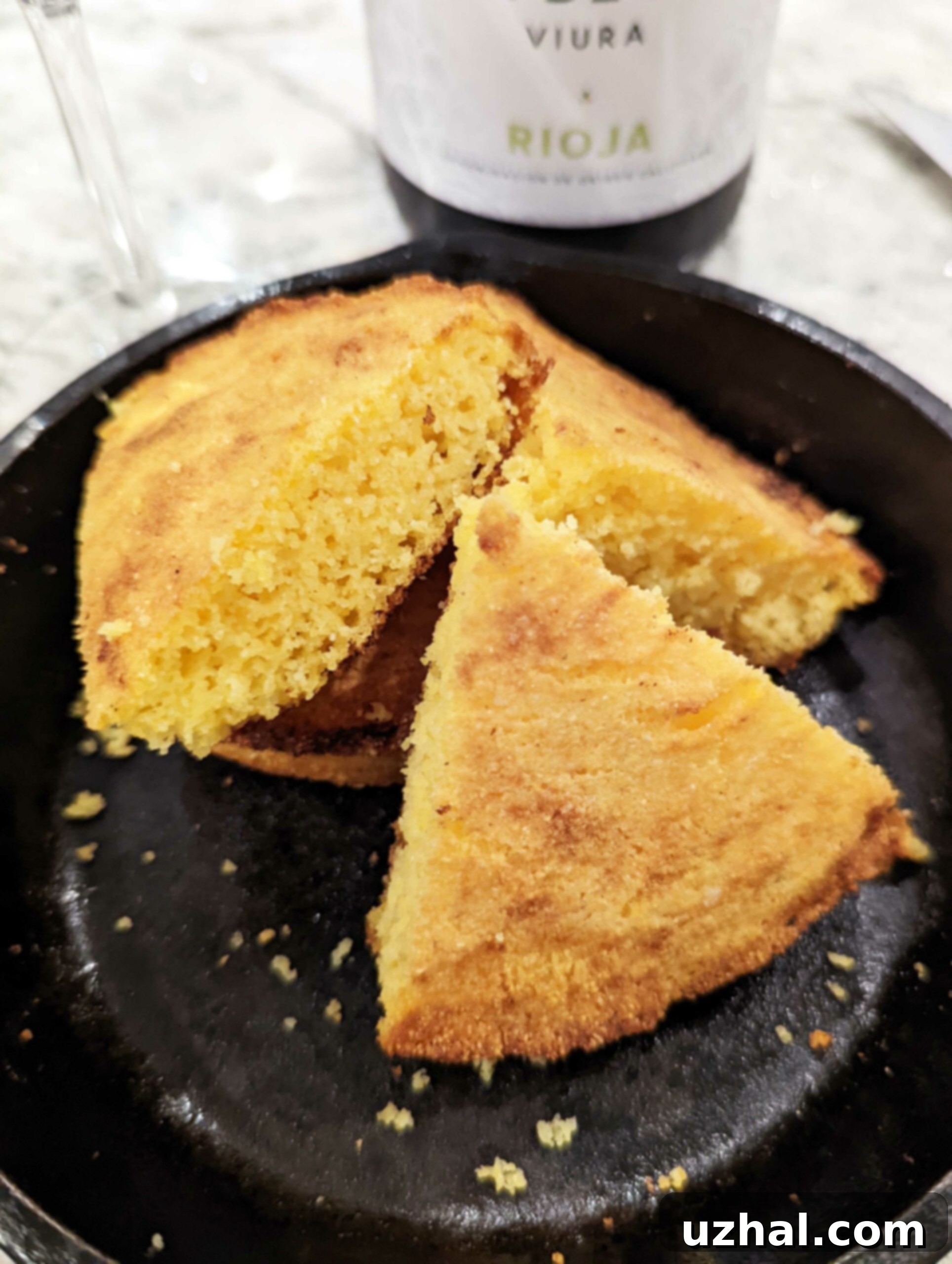
For those who find themselves still partial to cornbread with a touch of flour and sugar, and prefer a slightly sweeter profile, I’ve got you covered. Here’s a link to my usual, beloved recipe, Small Batch Skillet Cornbread. It offers a different, yet equally delicious, experience. However, I wholeheartedly encourage you to give this Lowcountry, no-flour, no-sugar version a try. It might just surprise you and convert you to the traditional, savory side of cornbread, as it did me!
- Million Dollar Double Delight Peanut Butter vs. Scratch
- Fudgy, Chewy, Cakey Brownies
- Chocolate Dream Pie –No Dream Whip
- Caramel Bliss Scones
- Alfajores
Recipe
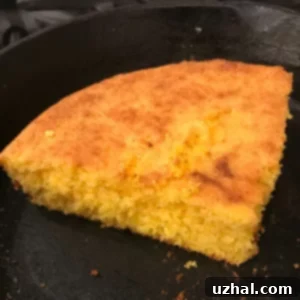
No Flour No Sugar Lowcountry Cornbread
Anna
Pin Recipe
Ingredients
- 2 slices bacon, for greasing the skillet (or 2 teaspoons melted butter/oil)
- 1 ¾ cups fine cornmeal (Quaker or Publix brand recommended)
- 1 teaspoon salt (scant, adjust to taste)
- 2 cups buttermilk (preferably whole milk cultured for best results)
- 1 large egg
- 1 teaspoon baking powder (scant)
- 1 teaspoon baking soda (scant)
Instructions
-
Preheat your oven to a blazing 450 degrees F (232 degrees C). A hot oven is crucial for that perfect crust.
-
In a sturdy 9 or 10-inch cast iron skillet, begin frying 2 to 4 slices of bacon. As the bacon cooks and renders its fat, you can prepare the cornbread batter. If you prefer not to use bacon, simply melt 2 teaspoons of butter or your chosen oil directly in the skillet and heat it until shimmering hot.
-
It’s important to remember that the cooked bacon itself is not incorporated into the cornbread batter! Enjoy the crispy bacon on its own, use it as a flavorful topping for salads, or save it for another culinary creation.
-
In a large mixing bowl, combine the cornmeal and salt. Create a spacious well in the center of the dry ingredients. Into this well, add the large egg and the cultured buttermilk. Whisk the egg and buttermilk together gently within the well, then gradually incorporate the dry ingredients until just combined. Be careful not to overmix; a few lumps are perfectly fine. Do not add the baking powder and baking soda at this stage.
-
While preparing your batter, keep a close eye on your bacon (if using) and ensure your baking powder and baking soda are measured and ready. Timing is crucial here: you want to finalize the cornbread batter just as your skillet is perfectly hot and ready.
-
Carefully remove the cooked bacon from the skillet. Then, with extreme caution, drain most of the rendered bacon grease into a heat-safe container (such as an old coffee can or a glass bowl), leaving behind approximately 2 teaspoons of fat in the skillet. Feel free to eyeball this measurement – a little more or less won’t significantly harm the outcome. The goal is a thin, even layer that ensures a crispy base.
-
Now, quickly whisk the baking powder and baking soda into your cornmeal mixture. This should be done just before pouring into the hot skillet to ensure maximum leavening power.
-
Carefully place the super hot skillet onto a rimmed baking pan (this is an important safety step, especially if your skillet is very full). Promptly pour the prepared cornbread batter into the sizzling hot skillet. You should hear a satisfying sizzle as the batter hits the hot fat.
-
Transfer the baking pan with the hot skillet into the preheated oven. Bake for approximately 20 minutes, or until the edges are golden brown and a wooden skewer inserted into the center comes out clean. If you’re confident that your batter won’t overflow, you can certainly skip the rimmed baking sheet. Having baked this cornbread many times, I sometimes forgo it. However, for your first attempt or if you prefer to err on the side of caution, please use something underneath to catch any potential drips and ensure a clean oven.
-
Allow the cornbread to cool slightly in the skillet before carefully inverting it onto a cutting board. Cut it into traditional wedges or squares and serve warm.
-
To store any delightful leftovers, simply place them in a zipper-top bag or an airtight container and refrigerate. This cornbread also freezes beautifully for longer storage; just wrap individual slices tightly in plastic wrap and then aluminum foil before freezing.
Nutrition